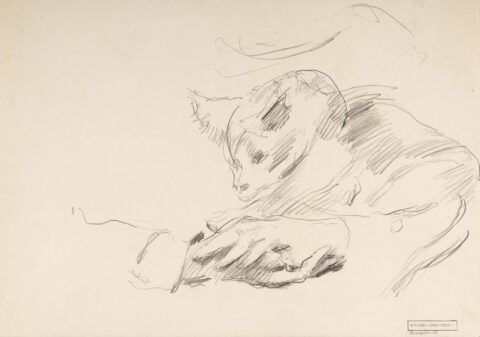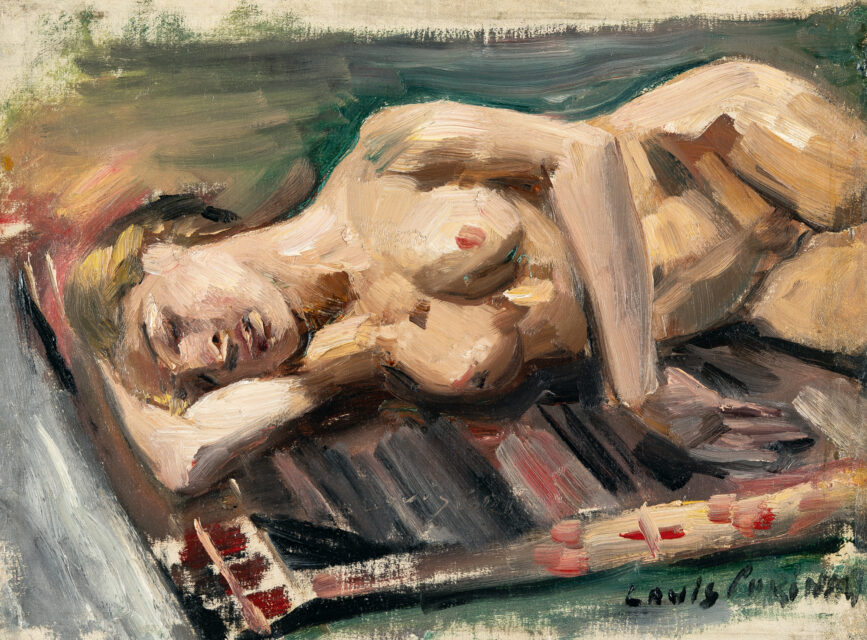
Female demi-nude
Details
With various hand-written notes and on the reverse on the stretcher. Berend-Corinth/Hernad 561. Exhibitions: Niedersächsische Landesgalerie/Landesmuseum, Hannover, 1953 (Leihgabe of Elsa Doebbeke). Provenance: Dr. Conrad Doebbeke (1889-1954), Berlin; Elsa Doebbeke, geb. Magnussen (1895-1971) und Tomy Doebbeke (1926-1992), Hannover, 1954 durch Erbschaft vom Vorgenannten; Lempertz, Cologne 28.10.1958, lot 53 (wohl nicht verkauft); Roman Norbert Ketterer, Stuttgart 29./30.5.1959, lot 159 (nicht verkauft lt. Ergebnisliste); private collection; private collection, Switzerland; Christie’s, London 3.2.2016, lot 346, with label on the back of the frame; private collection, Berlin.
Descrizione
• Intimate yet confident depiction of a female nude
• Reduced colour palette and interesting use of light
• From the artist’s Berlin period
As one of the main protagonists of German Impressionism and the Berlin Secession, Lovis Corinth, like his fellow artists Max Liebermann and Max Slevogt, moved between the poles of tradition and modernity throughout his life. Even if motifs from ancient mythology or 19th century academic art often appear among his subjects, his artistic interpretation of these themes shows a hitherto unknown realism. This is another reason why his works seem so astonishingly modern and fresh to us today – at the time, however, they polarised the public time and again. 1913, the year in which “Female Demi-Nude” was created, was the peak of Lovis Corinth’s career. He had recovered from the stroke he had suffered two years earlier, as a result of which he was unable to paint for a whole year. Georg Biermann published the first comprehensive monograph on Corinth, and in the same year Paul Cassirer organised a major retrospective of 228 oil paintings. Corinth chooses an interesting perspective with a slight top-down view for the depiction of the reclining female nude. It appears to be a work created spontaneously in the moment rather than a carefully planned composition: the image does not show the woman’s entire body, the background is only sketchily captured and, due to the green tones at the top and bottom of the picture, suggests an outdoor situation – perhaps a bathing scene by the lake. The woman lies asleep, her head resting on her bent arm, on a blanket with a red, brown and black pattern. Thanks to the subdued use of colour and the interesting interplay of light and shadow, the depiction focuses entirely on the naked body. Unfortunately, our provenance research has not been able to reconstruct any exhibition, auction or collection records for the “Female Demi-Nude” before 1953 and before it was housed in the collection of Dr. Conrad Doebbeke, Berlin. No restitution claims were made at the three public auctions in 1958/59 and 2016. The painting is not listed as Nazi-looted art in the Lost Art Database of the German Centre for Lost Cultural Property (as of 31 October 2023).
* Tutte le informazioni includono la commissione a carico dell'acquirente (27%) senza IVA e senza garanzia. Salvo errori.
** Tutte le informazioni più la commissione a carico dell'acquirente e l'IVA e senza garanzia. Salvo errori.
*** Con riserva: L'offerta è stata accettata al di sotto del limite. L'acquisizione dell'opera potrebbe essere ancora possibile nella nostra vendita post-asta.
R = Le opere d'arte regolarmente tassate
N = Opere d'arte soggette a tassazione differenziata e provenienti da un paese non UE
Non è consentita la riproduzione e la distribuzione privata o commerciale di tutte le illustrazioni delle opere esposte nell'archivio della mostra e dell'asta. Tutti i diritti riservati.


